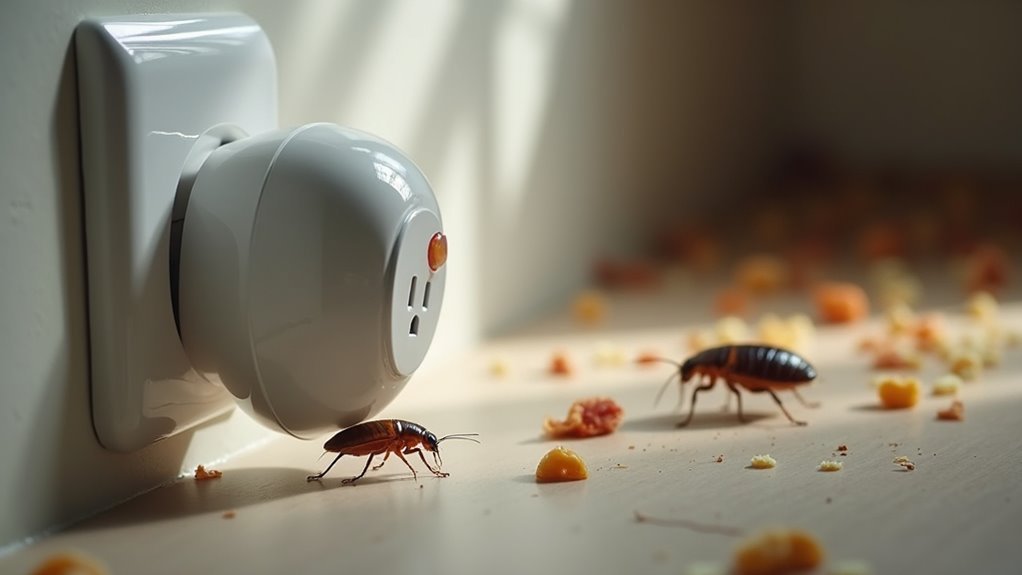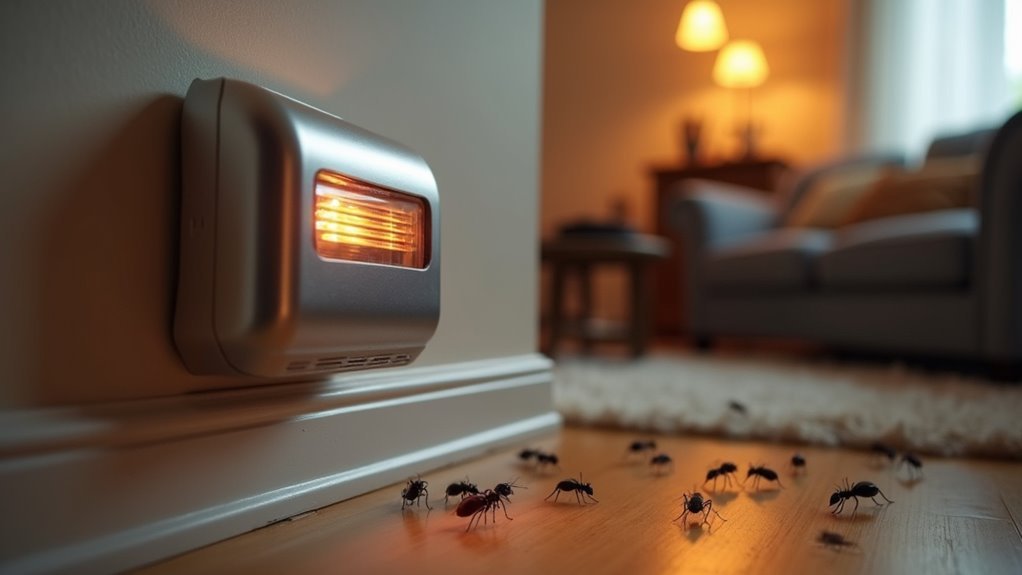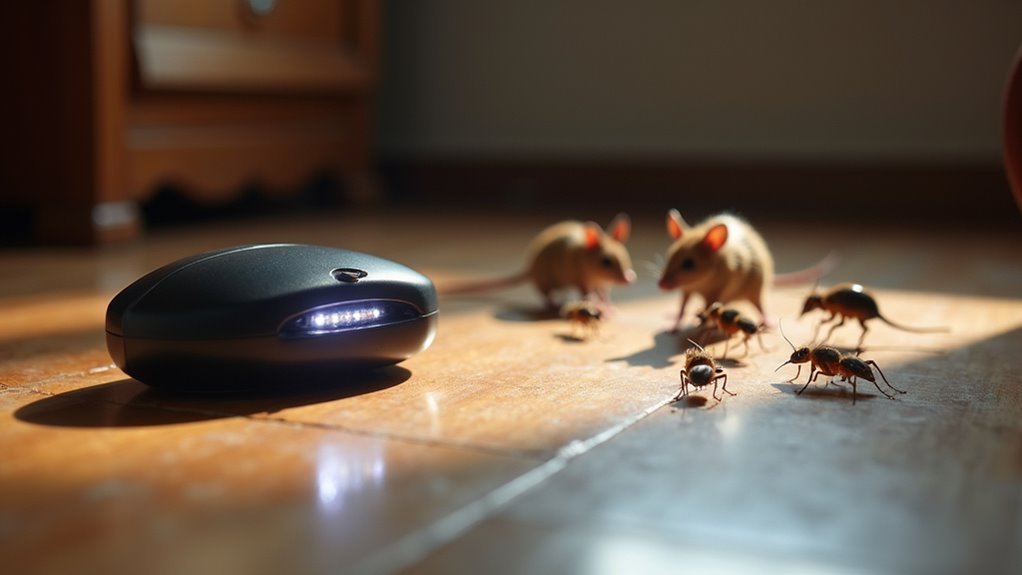You’re wasting money on ultrasonic pest repellers because they simply don’t work against common household pests. These devices emit high-frequency sound waves above 20,000 Hz that manufacturers claim disrupt pest behavior, but rigorous scientific studies consistently show no meaningful response from bed bugs, cockroaches, mice, ants, or spiders. Even when pests initially react, they quickly adapt within 3-7 days, making the devices useless for long-term control. Understanding the specific reasons behind their failure will help you make smarter pest control decisions.
What Are Ultrasonic Pest Repellers and How Do They Work

Electronic pest control has evolved beyond traditional traps and chemicals, introducing ultrasonic pest repellers as modern alternatives.
These devices emit high-frequency sound waves above 20,000 Hz that you can’t hear but supposedly disrupt pests like rodents and insects. Manufacturers claim these waves interfere with pest communication and navigation, causing discomfort that drives them away from your home.
Ultrasonic repellers emit inaudible high-frequency waves that manufacturers claim disrupt pest communication and cause discomfort driving them away.
You’ll find these devices marketed as eco-friendly solutions for household pests without toxic chemicals.
However, scientific studies reveal significant limitations. The effective range spans only 20-30 feet, and waves can’t penetrate walls or obstacles. More problematically, pests quickly become accustomed to the sounds. Rodents typically adapt within days, rendering the devices useless for long-term pest control in your home.
The Science Behind High-Frequency Sound Waves
While ultrasonic repellers operate on frequencies above 20 kHz, the physics behind these high-frequency sound waves reveals fundamental limitations that manufacturers rarely emphasize.
These sound waves can’t penetrate walls or obstacles, creating “shadow zones” where pests remain unaffected. Scientific evidence demonstrates that common household pests like bed bugs and cockroaches show no behavioral response to ultrasonic frequencies, undermining claims about their ability to repel these invaders.
You’ll find that even initially responsive pests adapt quickly, becoming desensitized within 3-7 days. This rapid habituation destroys any temporary effectiveness the devices might possess.
The Federal Trade Commission has specifically warned manufacturers about making unsubstantiated claims regarding ultrasonic pest control, highlighting the significant gap between marketing promises and actual scientific research on these products’ performance against real-world pest problems.
Laboratory Studies Reveal Limited Effectiveness

When researchers put ultrasonic pest repellers to rigorous scientific testing, the results consistently expose their marketing claims as fiction.
Laboratory studies demonstrate that these ultrasonic devices fail spectacularly against common household pests. A 2012 study found bed bugs showed zero behavioral response to ultrasonic frequencies. German cockroaches proved equally unimpressed, exhibiting no repelling activity whatsoever during controlled tests.
You’ll find that mice, ants, and spiders also ignore ultrasonic sounds completely.
Even worse, pests that initially react become desensitized within days, adapting quickly to the high-frequency noise.
Multiple research reviews conclude these devices are ineffective and lack scientific support. The evidence overwhelmingly shows that ultrasonic repellers don’t alter pest behavior in any meaningful way, making them worthless for real-world pest control situations.
Why Pests Quickly Adapt to Ultrasonic Frequencies
When you first use ultrasonic repellers, pests haven’t yet learned to ignore the high-frequency sounds bombarding them.
However, you’ll notice their effectiveness rapidly diminishes as rodents and insects begin the habituation process, fundamentally training their nervous systems to filter out these repetitive acoustic signals.
Within just 3 to 7 days, you’re left with devices that produce sounds your target pests have completely learned to disregard.
Pest Habituation Process
Although ultrasonic repellers initially startle pests with high-frequency sounds, these creatures quickly develop a tolerance that renders the devices useless.
You’ll find that pest habituation occurs remarkably fast, typically within 3 to 7 days of exposure to ultrasonic frequencies. During this adaptation period, rodents and insects learn to ignore the distress signals that once frightened them away.
This survival mechanism allows pests to recognize that the sounds pose no actual threat.
Studies demonstrate that mice and cockroaches show initial reactions but quickly return to normal behavior patterns. Once habituation sets in, these creatures exhibit no significant behavioral changes despite continued ultrasonic exposure.
This rapid adaptation process explains why these devices become ineffective for long-term pest control solutions.
Sound Desensitization Timeline
Within 24 hours of initial exposure, most pests begin showing reduced startle responses to ultrasonic frequencies, marking the start of a rapid desensitization process that ultimately defeats these devices.
You’ll notice that rodents particularly adapt quickly to the sound, with studies documenting significant behavioral changes within the first few days. By day three, most pests have become substantially desensitized to the frequencies that initially caused avoidance behavior.
The timeline consistently shows that ultrasonic repellers become ineffective within one week of continuous operation.
Your investment in these devices proves futile as pests resume normal activities, feeding and nesting behaviors returning to pre-exposure levels.
This rapid adaptation means ultrasonic frequencies can’t maintain long-term effectiveness to deter unwanted visitors from your property.
Physical Limitations of Ultrasonic Wave Penetration

You’ll find that ultrasonic waves can’t penetrate walls, doors, or other solid barriers in your home, severely limiting their reach.
This creates “shadow zones” behind obstacles where pests can hide and remain completely unaffected by the device.
Your ultrasonic repeller fundamentally becomes useless in rooms or areas separated by physical barriers from where you’ve placed the unit.
Wall Penetration Barriers
When ultrasonic waves encounter solid barriers like walls, doors, or furniture, they can’t penetrate through these materials and instead bounce back or get absorbed entirely.
This creates significant shadow zones throughout your home where pests remain completely unaffected by the device. Unlike other pest control methods that can reach hidden areas, ultrasonic repellers suffer from severe wall penetration issues that render them devices ineffective in multi-room environments.
Your carpets, curtains, and upholstered furniture will absorb sound waves, while solid surfaces reflect them away from target areas.
This means pests living inside walls, behind appliances, or in adjacent rooms continue their activities undisturbed. The limited effective range becomes even more restricted when obstacles block the signal path, creating pest-friendly sanctuaries throughout your property.
Shadow Zone Creation
Beyond the wall penetration problems lies an even more troubling issue: ultrasonic devices create extensive shadow zones that provide safe havens for pests throughout your home.
These pest repellers can’t overcome their limited distance of 20-30 feet, leaving vast areas unprotected. When ultrasonic waves encounter furniture, appliances, or decorative objects, they create acoustic shadows where rodents and insects freely roam.
The frequency range of these devices makes them susceptible to absorption by common household materials, fragmenting coverage even further. Environmental factors like humidity and dust compound this problem by weakening wave propagation.
As pests adapt to these predictable patterns, they’ll simply relocate to shadow zones, rendering your investment worthless while you remain unaware of their continued presence.
Federal Trade Commission Warnings About Unproven Claims
Although ultrasonic pest repellers flood the market with bold promises, the Federal Trade Commission hasn’t remained silent about their questionable claims.
In 2001, the FTC issued warning letters to over 60 companies for making unsubstantiated efficacy claims about their ultrasonic pest repellers. The commission expressed serious concerns that manufacturers lack scientific evidence supporting their assertions.
Studies consistently demonstrate that ultrasonic pest repellers don’t produce significant behavioral response in common household pests.
The FTC warns you that relying on these devices creates false security, potentially delaying effective pest control measures. This regulatory oversight emphasizes the critical gap between marketing claims and actual performance.
You’re fundamentally purchasing products that promise results they can’t deliver, leaving your pest problems unresolved while manufacturers profit from unproven technology.
Target Pest Species and Response Variations
While manufacturers market ultrasonic repellers as universal pest solutions, different species respond dramatically differently to these devices—or don’t respond at all.
You’ll find that ultrasonic pest repellers prove ineffective against common household pests like cockroaches and bed bugs, showing no significant behavioral changes in scientific studies.
Different pests have varying sensitivity to sound frequencies, meaning what might work for one species won’t affect another.
Rodents initially show some response but quickly adapt within days, making long-term control impossible.
Insects such as ants and spiders demonstrate zero response to ultrasonic devices in laboratory tests.
These response variations highlight why ultrasonic technology fails as a thorough pest management solution, despite marketing claims suggesting otherwise.
Environmental Factors That Reduce Device Performance
Even when ultrasonic repellers target the right pest species, numerous environmental conditions severely limit their performance in real-world settings.
You’ll find that ultrasonic sound waves have an effective range of only 20-30 feet, making obstacles like walls and furniture create shadow zones where pests escape undetected.
Environmental conditions such as humidity and dust absorb these sound waves, while background noise from appliances interferes with their frequencies.
Larger rooms pose additional challenges since the waves can’t reach all areas effectively.
The placement of the device becomes vital—if you position it away from known pest activity areas, you’re fundamentally wasting its limited capabilities.
These factors collectively undermine the device’s intended pest control function.
Safety Concerns for Pets and Medical Devices
Beyond their questionable effectiveness, ultrasonic pest repellers present serious safety concerns that manufacturers often downplay or ignore entirely.
These devices emit high-frequency sounds that can severely distress small pets like guinea pigs, hamsters, and rabbits. You’ll need to evaluate potential risks if you own these animals, as the sounds cause genuine discomfort.
Small pets like guinea pigs and hamsters experience genuine distress from ultrasonic frequencies, requiring careful risk evaluation before use.
Medical devices pose another major concern. If you use hearing aids or pacemakers, ultrasonic pest repellers can interfere with their function, creating dangerous situations. You should consult your doctor before installing these devices.
Additional adverse reactions include interference with burglar alarms and telephone conversations.
The lack of thorough research on long-term exposure effects makes these safety concerns even more troubling for both pets and humans.
Cost Analysis Compared to Professional Pest Control
You’ll initially spend $20 to $50 on an ultrasonic repeller, which appears cheaper than professional pest control services that cost $100 to $300 for initial treatments.
However, you should consider whether this upfront savings translates to actual long-term value when these devices often fail to deliver promised results.
You might end up purchasing multiple units or additional pest control methods, potentially exceeding the cost of hiring professionals from the start.
Initial Purchase Costs
At first glance, ultrasonic pest repellers appear to offer significant savings with their $20 to $100 price tags compared to professional pest control services that typically cost $100 to $300 per treatment.
However, these initial purchase costs can be misleading when you consider their questionable effectiveness. You’ll often find yourself making additional spending decisions when these devices fail to deliver results.
Many homeowners end up purchasing multiple ultrasonic pest repellers, sometimes exceeding $200 in total costs while searching for a working solution.
Meanwhile, professional pest control services typically provide long-term solutions with a single visit, making their higher upfront investment more cost-effective than repeatedly buying ineffective devices that don’t address your pest problems.
Long-Term Value Comparison
When examining the true financial impact over months or years, ultrasonic pest repellers become a costly gamble that rarely pays off.
You’ll likely need multiple ultrasonic devices to cover larger areas, with each unit costing $20-50 but offering limited 20-30 foot ranges. Since studies show these devices lack long-term effectiveness against common pests, you’re often forced to purchase additional units or eventually hire professional pest control anyway.
Professional pest control services start around $100 but provide thorough strategies targeting food sources and entry points that ultrasonic devices can’t address. This prevents larger pest infestations and related damage costs.
While ultrasonic repellers seem cheaper initially, their ineffective nature makes professional services the more cost-effective long-term solution.
Customer Review Patterns and Misleading Feedback
Thousands of online reviews for ultrasonic pest repellers paint a confusing picture that doesn’t align with scientific evidence.
You’ll find customer review patterns showing high ratings despite questionable effectiveness, creating misleading feedback that obscures reality. Many users report success but simultaneously use traditional pest control methods, making it impossible to isolate the device’s impact.
High ratings mask poor performance when customers unknowingly credit ultrasonic devices for results achieved by conventional pest control methods.
These anecdotal experiences often ignore environmental factors that naturally reduce pest activity.
You’re encountering fraudulent reviews that inflate ratings and create unrealistic expectations.
When you rely on subjective testimonials instead of scientific evidence, you’re distracted from proven ultrasonic pest repellers alternatives.
The high star ratings don’t reflect actual performance but rather consumer psychology and concurrent pest control solutions that deserve the real credit for results.
Proven Alternative Pest Control Methods
While ultrasonic repellers fail to deliver reliable results, proven pest control methods offer effective pest control solutions you can implement immediately. Professional pest control services use targeted treatments like specialized baits and traps designed for specific pests, ensuring reliable management and elimination.
| Method | Approach |
|---|---|
| Preventive | Sealing entry points, removing food/water sources |
| DIY Solutions | Snap traps, live traps, safe DIY pesticides |
| Professional | Regular quarterly pest control treatments |
These strategies address underlying infestation causes rather than relying on questionable deterrents. Combining preventive measures like decluttering with monitoring traps provides an effective alternative to chemical solutions. Professional services create protective barriers around your home, addressing seasonal pest activity while preventing escalation and delivering long-term cost savings.
Frequently Asked Questions
How Reliable Are Ultrasonic Pest Repellers?
You’ll find ultrasonic pest repellers aren’t reliable for controlling pests. They lack scientific support, have limited range, and pests quickly adapt to the sounds, making them ineffective as standalone solutions.
Do Ultrasonic Pest Repellers Work on Insects?
You’ll find that ultrasonic pest repellers don’t work effectively on insects like cockroaches, mosquitoes, or bed bugs. Scientific studies consistently show these devices have little to no impact on common insect pests.
What Are the Disadvantages of Ultrasonic Pest Repellers?
You’ll face limited range coverage, pest adaptation within days, lack of scientific evidence, interference from furniture and noise, plus you might delay effective treatments while infestations worsen.
Do Ultrasonic Devices Really Repel Rodents?
You won’t find ultrasonic devices effectively repelling rodents. They can’t produce significant behavioral changes, rodents quickly adapt within days, and scientific studies consistently show no evidence of effectiveness against mice or rats.
In Summary
You’ve seen the evidence: ultrasonic repellers simply don’t deliver on their promises. The science proves pests adapt quickly, sound waves can’t penetrate effectively, and lab studies show minimal results. You’re better off investing in proven methods like sealed entry points, baits, or professional services. Don’t waste your money on gadgets that rely on misleading marketing rather than solid pest control principles. Choose solutions that actually work.





Leave a Reply